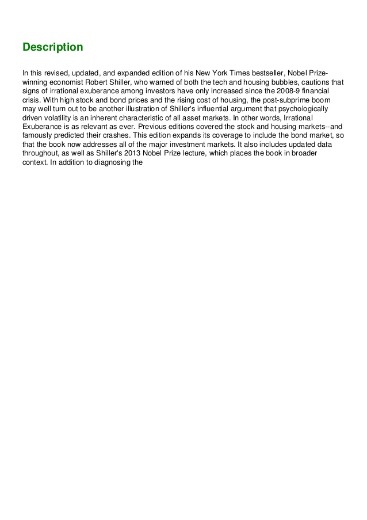Irrational Exuberance Book
Table of Contents Heading
- Irrational Exuberance (summary)
- The Price
- Robert Shiller And Irrational Exuberance
- Pass On This One And Read The Black Swan
- Security Analysis: Sixth Edition
- Part Three Psychological Factors
- When Should I Sell A Losing Stock?
It ends with a section on implication of these findings on the various members of society whether individuals, institutions or government. From the very beginning Shiller is interested in showing how changes in stock prices, real estate prices, and bond prices cannot be accounted for by changes in fundamentals. If we think fundamentals explain most of the changes in stock prices then there is no need for any other explanations. One point that comes up again and again the book is that investing in stocks and real estate is not a strategy that can be counted on to generate high returns. He argues that in almost all the cases stock prices first go up and then after the fact people start to put stories together to justify the rise in stock prices. In Chapter Four he identifies precipitating factors that he argues are not connected to fundamentals.

Previous editions covered the stock and housing markets – and famously predicted their crashes. Investors sell at any cost, sending prices below their real value. An economic contraction follows, usually leading to a recession. Irrational exuberance is usually how a stock market crash causes a recession. The third edition of Irrational Exuberance by Shiller analyses and explains the influence of structural, cultural, and psychological factors in the creation of bubbles. The book reads as the mix of an academic economic research paper and a popular non-fiction book, and contains an abundance of useful references to prior research. The other book was Andrew Smithers’ and Stephen Wright’s Valuing Wall Street.
While I’ve leaned on Shiller’s ideas and information heavily in a decision not to spend a large percentage of my net worth on a house, I came away from this book thinking intensely about how much I’ve leaned on the stock market. Shiller’s idea of wise investing is clearly different form that espoused by the 401k support brought-in by the financial institutions holding the funds. I will look closely again at how my money is invested. The ideas of psychology and economic fundamentals are contrasted toward the middle of the book with the “efficient markets” theory. This theory essentially says that the market, in the long term, will always obey supply and demand laws. All of the people transacting to make up the economy serve to even-out lawbreaking events and therefore, the economy lends itself to predictability and, even, calculation.
The common feature for all bubbles is the creation of azeitgeist – a spirit of the age, or consensus regarding a “new era”. Any bull market go through the same stages time and time again. A zeitgeist – spirit of the age – concerning a “new era” drives stock prices to levels where the gap between underlying earnings power and price widens to a degree that smells like a bubble. During this buying frenzy, afeedback loopoccurs where market participants drive prices ever higher exactly because of the recent past’s positive price movements. To come full circle, information cascades and excessive confidence lure in more participants, which again drives prices ever higher.
Irrational Exuberance (summary)
The larger the outcome on the wheel, the more countries people thought were in the U.N.–even though the wheel’s outcome was extraneous. Get one to fit every reader’s tastes., except the purchase of e-books online. Still, is one really clairvoyant because of their proven ability to repeat themselves even when they are wrong up until they are eventually right? I’ll leave that up to others to decide for themselves. At the end of the day, I respect the game and the hustlers who play it. I assume their theory is if you predict it will rain long enough, then you will inevitably be proven right because of the statistical probability that one day it will in fact rain, again. Or maybe even when they are obviously wrong, they actually did believe what they are saying while they were saying it.

Those emotions he argues play a key role in how people behave. I believe Shiller is rejecting that people lose control of themselves and act like some out of control mob. When bubbles collapse they so for reasons that are not related to fundamentals. • The chapter on the news media goes through examples that are designed to show that there was no news that could have justified the stock price changes that occurred. • The chapter on herd behavior and epidemics is an attempt to show how people are drawn into the market not because of changes in fundamentals but because of the influence of authority, because of behavior that can be described by models of epidemics. We have talked about efficient markets and in Chapter Eleven Shiller explicitly introduces the theory of efficient markets. Instead of giving investment advice to individuals that is not supported by the evidence, we should work on developing financial instruments that would help people hedge against risks that they face from interruptions in their flow of income.
The experience of being laid off, or at least knowing of others who had been, was often viewed as a violation of an implicit pact of loyalty between employee and employer. Such an experience encouraged workers to take control of their own lives and rely less on their employers and to become, in effect, economic entities unto themselves rather than parts of a larger economic organization. There is some good discussion of “efficient markets” and what makes markets act inefficient. It wasn’t going to make every company in the S&P more profitable by huge amounts. I wish I had read this when I was younger, rather than reading books like ‘the Dow 20,000’ etc. What I found most useful was Shiller’s precise and conservative approach to researching things. He would offer a lengthy analysis of the news around crises, detail surveys he sent out at the time, focus on the impact of phrasing of these surveys etc.
The Price
For many people, investment decisions are not based on statistics and numbers. There is an emotional component to them as well, just like a decision about where to go for vacation. Gambling is more popular in America now than it was at any time since the 1870s, when most gambling was made illegal. Gambling has been legalized in many states and encouraged by lotteries, which have spread throughout the country. The increase of gambling may encourage other forms of risk taking. Want to get the main points of Irrational Exuberance in 20 minutes or less?

Ever since Adam Smith, the central teaching of economics has been that free markets provide us with material well-being, as if by an invisible hand. In Phishing for Phools, Nobel Prize-winning economists George Akerlof and Robert Shiller deliver a fundamental challenge to this insight, arguing that markets harm as well as help us. As long as there is profit to be made, sellers will systematically exploit our psychological weaknesses and our ignorance through manipulation and deception. The legendary investor shows how to identify and master the cycles that govern the markets. We all know markets rise and fall, but when should you pull out, and when should you stay in? The answer is never black or white, but is best reached through a keen understanding of the reasons behind the rhythm of cycles.
It’s interesting that when the market goes up, people assume it makes sense, because they’re making money and they like it. But when the market goes down, they think it’s an over-reaction, because they liked the higher number better — because that was their imagined net worth. Shiller gives examples that are designed to show that prices are much more volatile than we would expect if prices are driven by fundamentals. But at various points Shiller talks about the role of emotions. On p. 80 of the third edition he talks about the emotions of regret and envy.
There are plenty of statistics, charts, and graphs to illustrate all the points. But there are no tests of strategies to help avoid bubbles, or better yet, how to take advantage of the bubbles. There are currently three editions of the book published, with the latest occurring in 2015. Shiller points to much of his analytical work concerning the history of the markets to illustrate his belief that the EMH is wrong and has several systemic problems. Others so influence investors that we often will change our opinions in the face of the majority of people that have a differing opinion. He points out several studies that prove that rational people believe the majority is correct when compared to their own opinions. In this chapter, Shiller discusses some of the psychological anchors that influence investors.
Robert Shiller And Irrational Exuberance
As always, thank you for taking the time to read this post, and I hope you find something of value to help you with your investing journey. Robert Shiller is still quite active in the investment world, and he teaches behavioral investing at Yale. Shiller is also famous for creating the CAPE ratio, which helps define the Shiller P/E, which is commonly referred to whenever anyone is discussing the valuation of the markets. Even though the book has been updated three times, not much new material has been added over the years. The book is repetitive, the same formula and material presented over and over again, rather than exploring options to avoid or profit from the market bubbes. The focus of the book is on the investor’s irrational exuberance and illustrating the reasons for this exuberance.
He also made the point that the internet hasn’t really had that much of an effect on the market. Ultimately the reason that studies have not found stronger evidence that people who are smarter tend to make more money is that there is no good way to measure how smart investors are. We do not have databases giving the IQ scores of investment managers to enable us to to compare their performance with their scores, and even if we did, it is not clear that the available intelligence tests would measure the right abilities.
- He shows how these bubbles led to the dangerous overextension of credit now resulting in foreclosures, bankruptcies, and write-offs, as well as a global credit crunch.
- This created an environment of self-reliance, which may explain why people are more individualistic today than they were previously.
- So, it pains me to say this as an auditor, contributor, and direct author of many dry and painful reports myself that this book is not an entertaining piece of literature.
- Materialistic values gained influence during a bull market, and people often sought to make money through real estate investments or stock trading.
- The original and bestselling 2000 edition of “Irrational Exuberance” evoked Alan Greenspan’s infamous 1996 use of that phrase to explain the alternately soaring and declining stock market.
The investors who get hit the hardest — the ones who are still all-in just before the correction — are the overconfident ones who are sure that the bull run will last forever. Trusting that a bull won’t turn on you is a sure way to get yourself gored. Irrational exuberance is widespread and undue economic optimism. When investors start believing that the rise in prices in the recent past predicts the future, they are acting as if there is no uncertainty in the market, causing a positive feedback loop of ever-higher prices. Irrational exuberance has become synonymous with the creation of inflated asset prices associated with bubbles, which ultimately pop and can lead to market panic.
Pass On This One And Read The Black Swan
Sometimes, are often times, just because a headline or story generates clicks does not mean it is the most relevant facts that you need to know. The media is a reflection of us, the people who click. In essence, we get the news we deserve so in some ways, we have no one to blame but ourselves for the results. That said, when it comes to financial news or financial pr0nography, you should, at a minimum, keep the following in mind as you click the next headline placed in front of you by an algorithm.
He delves into the history of past three peaks of exuberance in the 20th century. He discerned a similar trend emerging in the financial markets. Thus whereas Greenspan merely made such mentions about the irrationality , it was Schiller who not only analysed it but also attempted a prescription in terms of how the adverse impact of such an incipient crisis could possibly be mitigated. It is in this context that he advocates a reform of Social Security system.
Security Analysis: Sixth Edition
He thinks that rather a single factor, it is a combination of ratios unheard of before that cause the rise in prices, some of which the investors just can’t resist. One of the best aspects of the book is that it explains in depth the fluctuations of the stock market and the reasons behind those fluctuations.
This book is a must read/listen for all investors and/or economists. Robert Shiller describes in a very rational way the occational folly by the masses which creates investing bubbels in the economy. He warns that poorer performance may be in the offing and tells us how we – as a society and individually – can respond. As he did for the physical world in his classic The Fractal Geometry of Nature, Mandelbrot here uses fractal geometry to propose a new, more accurate way of describing market behavior.
Perhaps I’m giving him an extra star just for winning the Nobel Prize. Shiller is clearly a brilliant man and this book is well researched.
Part Three Psychological Factors
The graph clearly portrays that the index’ earnings range between $20-$40 throughout the period. The prices, on the other hand, move in a spectrum of $50-$1,500.
It does very much feel like this market is being manipulated based on many of the factors mentioned. An excellent piece on financial psychology that predicted not one, but two different crashes. Bubbles are those events which can’t reasonably be explained by fundamental ideas of business or economics. They are agreed to be strictly events of sociology or some outside influence that suddenly causes business or market changes by extraordinary force.
Pressing further, Shiller explained this predictability with psychological factors such as herding and fads and by this became one of the early key proponents of Behavioural Finance. During the 1990’s the cheeky Swedish TV- character Gert Fylking, dressed in an awful pink tracksuit had the habit of shouting “Finally! ” when the Nobel Prize committee announced another obscure literature prize winner to the waiting possy of pretentious culture journalists. This year I fully agree with Gert when it comes to the Nobel Prize in Economics, finally Bob Shiller gets the award. On the financial market Shiller is mostly know for the valuation multiple Shiller-PE and the Case- Shiller real estate index. However he’s a towering figure when it comes to financial theory that’s brought forward the still underappreciated notion that longer term average future returns vary with the starting valuation.
To restore confidence in the markets, Shiller argues, bailouts are needed in the short run. But he insists that these bailouts must be targeted at low-income victims of subprime deals. Spread through the public in the form of popular stories, ideas can go viral and move markets, whether it’s the belief that tech stocks can only go up, that housing prices never fall, or that some firms are too big to fail. Whether true or false, stories like these, transmitted by word of mouth, by the news media, and increasingly by social media, drive the economy by driving our decisions about how and where to invest, how much to spend and save, and more. But despite the obvious importance of such stories, most economists have paid little attention to them. Narrative Economics sets out to change that by laying the foundation for a way of understanding how stories help propel economic events that have had led to war, mass unemployment, and increased inequality.
It was the same thing in 1999 or thereabouts, when stories of some internet companies were coming out and people said, you know, this is the future, these guys are going to take over. The only time mistrust of the market was lower since 1989 was in 2000. It seems like the mindset is somewhat similar to the dot-com mindset.

